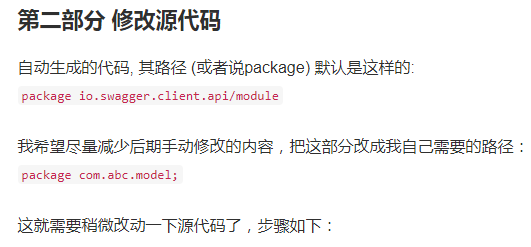swagger-codegen自动生成代码工具的介绍与使用
一、Swagger Codegen简介
Swagger Codegen是一个开源的代码生成器,根据Swagger定义的RESTful API可以自动建立服务端和客户端的连接。Swagger Codegen的源码可以在Github上找到。
GitHub: https://github.com/swagger-api/swagger-codegen
二、Swagger Codegen安装
首先机器上需要安装jdk,具体Java, version 7 or higher,然后在这里(https://oss.sonatype.org/content/repositories/releases/io/swagger/)找到需要的Swagger Codegen版本来安装,不过官方是推荐最新版本。
只要下载一个cli的jar文件就可以了,例如, swagger-codegen-cli-2.2.1.jar(已共享到QQ群文件:301343109)。也可以直接在命令行里下载,例如
Wget https://oss.sonatype.org/content/repositories/releases/io/swagger/swagger-codegen-cli/2.2.1/swagger-codegen-cli-2.2.1.jar
下载好了,运行
java -jar swagger-codegen-cli-2.2.1.jar
根据返回结果可以看到Swagger Codegen支持的语言有很多: [android, aspnet5, async-scala, cwiki, csharp, cpprest, dart, flash, python-flask, go, groovy, java, jaxrs, jaxrs-cxf, jaxrs-resteasy, jaxrs-spec, inflector, javascript, javascript-closure-angular, jmeter, nancyfx, nodejs-server, objc, perl, php, python, qt5cpp, ruby, scala, scalatra, silex-PHP, sinatra, rails5, slim, spring, dynamic-html, html, html2, swagger, swagger-yaml, swift, tizen, typescript-angular2, typescript-angular, typescript-node, typescript-fetch, akka-scala, CsharpDotNet2, clojure, haskell, lumen, go-server]
三、Swagger Codegen的使用
查看Swagger Codegen的帮助信息
java -jar swagger-codegen-cli-2.2.1.jar help generate
查看Swagger Codegen支持的具体某个语言的使用帮助,拿java举例
java -jar swagger-codegen-cli-2.2.1.jar config-help -l java
C:\Users\Administrator\Documents\swagger-coden>java -jar swagger-codegen-cli-2.3.0.jar help generate NAME swagger-codegen-cli generate - Generate code with chosen lang SYNOPSIS swagger-codegen-cli generate [(-a <authorization> | --auth <authorization>)] [--additional-properties <additional properties>...] [--api-package <api package>] [--artifact-id <artifact id>] [--artifact-version <artifact version>] [(-c <configuration file> | --config <configuration file>)] [-D <system properties>...] [--git-repo-id <git repo id>] [--git-user-id <git user id>] [--group-id <group id>] [--http-user-agent <http user agent>] (-i <spec file> | --input-spec <spec file>) [--ignore-file-override <ignore file override location>] [--import-mappings <import mappings>...] [--instantiation-types <instantiation types>...] [--invoker-package <invoker package>] (-l <language> | --lang <language>) [--language-specific-primitives <language specific primitives>...] [--library <library>] [--model-name-prefix <model name prefix>] [--model-name-suffix <model name suffix>] [--model-package <model package>] [(-o <output directory> | --output <output directory>)] [--release-note <release note>] [--remove-operation-id-prefix] [--reserved-words-mappings <reserved word mappings>...] [(-s | --skip-overwrite)] [(-t <template directory> | --template-dir <template directory>)] [--type-mappings <type mappings>...] [(-v | --verbose)] OPTIONS -a <authorization>, --auth <authorization> adds authorization headers when fetching the swagger definitions remotely. Pass in a URL-encoded string of name:header with a comma separating multiple values --additional-properties <additional properties> sets additional properties that can be referenced by the mustache templates in the format of name=value,name=value. You can also have multiple occurrences of this option. --api-package <api package> package for generated api classes --artifact-id <artifact id> artifactId in generated pom.xml --artifact-version <artifact version> artifact version in generated pom.xml -c <configuration file>, --config <configuration file> Path to json configuration file. File content should be in a json format {"optionKey":"optionValue", "optionKey1":"optionValue1"...} Supported options can be different for each language. Run config-help -l {lang} command for language specific config options. -D <system properties> sets specified system properties in the format of name=value,name=value (or multiple options, each with name=value) --git-repo-id <git repo id> Git repo ID, e.g. swagger-codegen. --git-user-id <git user id> Git user ID, e.g. swagger-api. --group-id <group id> groupId in generated pom.xml --http-user-agent <http user agent> HTTP user agent, e.g. codegen_csharp_api_client, default to 'Swagger-Codegen/{packageVersion}}/{language}' -i <spec file>, --input-spec <spec file> location of the swagger spec, as URL or file (required) --ignore-file-override <ignore file override location> Specifies an override location for the .swagger-codegen-ignore file. Most useful on initial generation. --import-mappings <import mappings> specifies mappings between a given class and the import that should be used for that class in the format of type=import,type=import. You can also have multiple occurrences of this option. --instantiation-types <instantiation types> sets instantiation type mappings in the format of type=instantiatedType,type=instantiatedType.For example (in Java): array=ArrayList,map=HashMap. In other words array types will get instantiated as ArrayList in generated code. You can also have multiple occurrences of this option. --invoker-package <invoker package> root package for generated code -l <language>, --lang <language> client language to generate (maybe class name in classpath, required) --language-specific-primitives <language specific primitives> specifies additional language specific primitive types in the format of type1,type2,type3,type3. For example: String,boolean,Boolean,Double. You can also have multiple occurrences of this option. --library <library> library template (sub-template) --model-name-prefix <model name prefix> Prefix that will be prepended to all model names. Default is the empty string. --model-name-suffix <model name suffix> Suffix that will be appended to all model names. Default is the empty string. --model-package <model package> package for generated models -o <output directory>, --output <output directory> where to write the generated files (current dir by default) --release-note <release note> Release note, default to 'Minor update'. --remove-operation-id-prefix Remove prefix of operationId, e.g. config_getId => getId --reserved-words-mappings <reserved word mappings> specifies how a reserved name should be escaped to. Otherwise, the default _<name> is used. For example id=identifier. You can also have multiple occurrences of this option. -s, --skip-overwrite specifies if the existing files should be overwritten during the generation. -t <template directory>, --template-dir <template directory> folder containing the template files --type-mappings <type mappings> sets mappings between swagger spec types and generated code types in the format of swaggerType=generatedType,swaggerType=generatedType. For example: array=List,map=Map,string=String. You can also have multiple occurrences of this option. -v, --verbose verbose mode
利用Swagger Codegen根据服务生成客户端代码
java -jar swagger-codegen-cli-2.2.1.jar generate -i http://petstore.swagger.io/v2/swagger.json -l java -o samples/client/pestore/java
在上面这段代码里,使用了三个参数,分别是-i和-l和-o。
-i指定swagger描述文件的路径,url地址或路径文件;该参数为必须(http://petstore.swagger.io/v2/swagger.json是官方的一个例子,我们可以改成自己的服务)
-l指定生成客户端代码的语言,该参数为必须
-o指定生成文件的位置(默认当前目录)
除了可以指定上面三个参数,还有一些常用的:
-c json格式的配置文件的路径;文件为json格式,支持的配置项因语言的不同而不同
-a 当获取远程swagger定义时,添加授权头信息;URL-encoded格式化的name,逗号隔开的多个值
--api-package 指定生成的api类的包名
--artifact-id 指定pom.xml的artifactId的值
--artifact-version 指定pom.xml的artifact的版本
--group-id 指定pom.xml的groupId的值
--model-package 指定生成的model类的包名
-s 指定该参数表示不覆盖已经存在的文件
-t 指定模版文件所在目录
生成好的客户端代码

生成的这些文件里,src文件下的文件和pom.xml文件是对我们最有用的。把它们导入到我们习惯用的java编辑器里,这里以eclipse为例,下面是导入好的客户端的maven工程,和我们平常新建的maven工程一模一样(已共享到QQ群文件:301343109)。

但是自动生成的客户端代码并不能直接使用,需要我们做一些修改,特别是io.swagger.client.api包下的class类,我们需要把void替换成各自的model。
改好后,我们就可以运行客户端test下的测试代码,进行单元测试了。拿PetApiTest类来举例,运行它的addPetTest()方法。

可以看到测试成功。
2019.6.23 更新
我们会发现生成的默认包是io.swagger.client.api/module,而我们可能想要自己的包,怎么办呢?我看网上居然有人说要改源码,以下是那篇文章的内容。

这边我想说swagger也是一个比较成熟的产品了,也这么多人在用了,怎么可能连修改默认的包这个基础的需求都不提供呢,说明这篇文章的作者,根本就没看Swagger Codegen的帮助信息,上面明明已经列出来了,只需要生成代码的时候指定--api-package这个选项就好了。
命令我贴出来
java -jar swagger-codegen-cli-2.3.1.jar generate -i http://xxxx:8807/static/swagger.json -l java -o C:\Users\Administrator\Documents\xx-java-gen --api-package com.xxxx.client --invoker-package com.xxxx.client.invoker --model-package com.xxxx.client.model
所以我们在学习和工作的时候,一定要灵活,多动脑。



 浙公网安备 33010602011771号
浙公网安备 33010602011771号